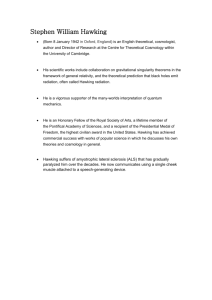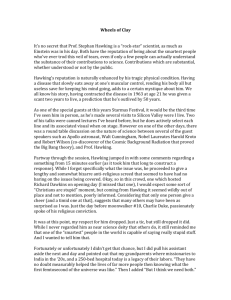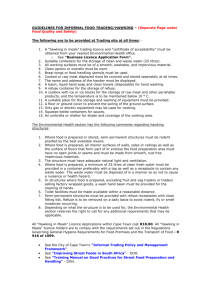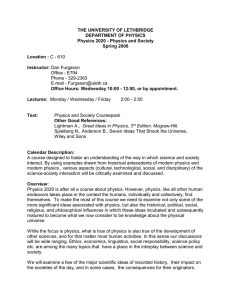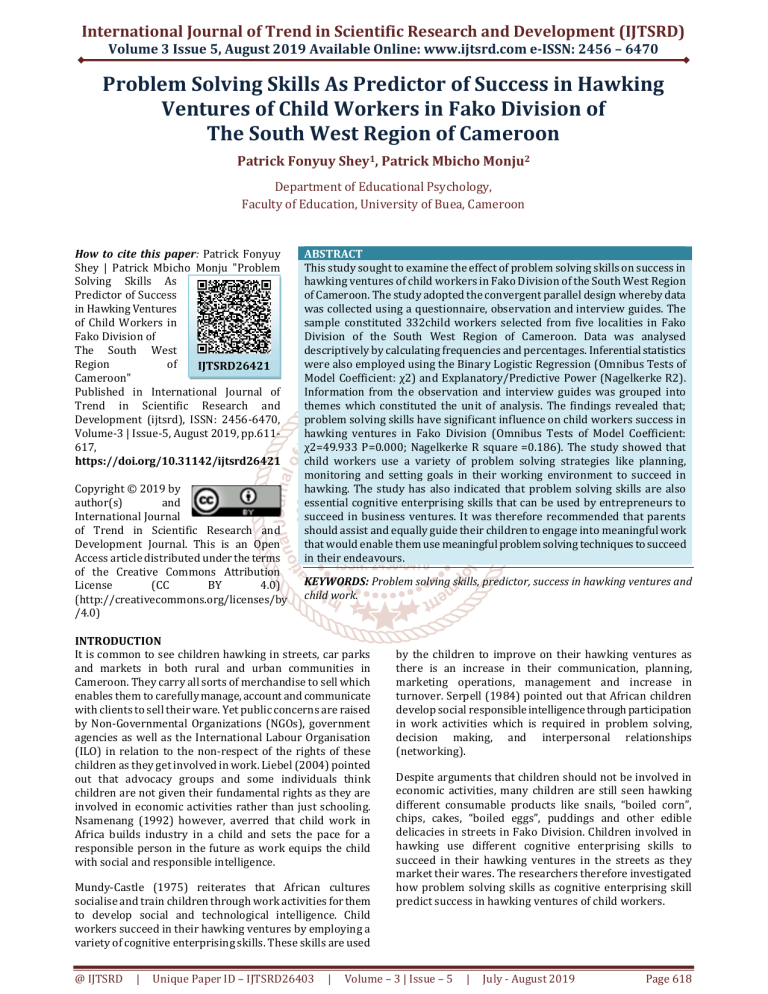
International Journal of Trend in Scientific Research and Development (IJTSRD)
Volume 3 Issue 5, August 2019 Available Online: www.ijtsrd.com e-ISSN: 2456 – 6470
Problem Solving Skills As Predictor of Success in Hawking
Ventures of Child Workers in Fako Division of
The South West Region of Cameroon
Patrick Fonyuy Shey1, Patrick Mbicho Monju2
Department of Educational Psychology,
Faculty of Education, University of Buea, Cameroon
How to cite this paper: Patrick Fonyuy
Shey | Patrick Mbicho Monju "Problem
Solving Skills As
Predictor of Success
in Hawking Ventures
of Child Workers in
Fako Division of
The South West
Region
of
IJTSRD26421
Cameroon"
Published in International Journal of
Trend in Scientific Research and
Development (ijtsrd), ISSN: 2456-6470,
Volume-3 | Issue-5, August 2019, pp.611617,
https://doi.org/10.31142/ijtsrd26421
Copyright © 2019 by
author(s)
and
International Journal
of Trend in Scientific Research and
Development Journal. This is an Open
Access article distributed under the terms
of the Creative Commons Attribution
License
(CC
BY
4.0)
(http://creativecommons.org/licenses/by
/4.0)
ABSTRACT
This study sought to examine the effect of problem solving skills on success in
hawking ventures of child workers in Fako Division of the South West Region
of Cameroon. The study adopted the convergent parallel design whereby data
was collected using a questionnaire, observation and interview guides. The
sample constituted 332child workers selected from five localities in Fako
Division of the South West Region of Cameroon. Data was analysed
descriptively by calculating frequencies and percentages. Inferential statistics
were also employed using the Binary Logistic Regression (Omnibus Tests of
Model Coefficient: χ2) and Explanatory/Predictive Power (Nagelkerke R2).
Information from the observation and interview guides was grouped into
themes which constituted the unit of analysis. The findings revealed that;
problem solving skills have significant influence on child workers success in
hawking ventures in Fako Division (Omnibus Tests of Model Coefficient:
χ2=49.933 P=0.000; Nagelkerke R square =0.186). The study showed that
child workers use a variety of problem solving strategies like planning,
monitoring and setting goals in their working environment to succeed in
hawking. The study has also indicated that problem solving skills are also
essential cognitive enterprising skills that can be used by entrepreneurs to
succeed in business ventures. It was therefore recommended that parents
should assist and equally guide their children to engage into meaningful work
that would enable them use meaningful problem solving techniques to succeed
in their endeavours.
KEYWORDS: Problem solving skills, predictor, success in hawking ventures and
child work.
INTRODUCTION
It is common to see children hawking in streets, car parks
and markets in both rural and urban communities in
Cameroon. They carry all sorts of merchandise to sell which
enables them to carefully manage, account and communicate
with clients to sell their ware. Yet public concerns are raised
by Non-Governmental Organizations (NGOs), government
agencies as well as the International Labour Organisation
(ILO) in relation to the non-respect of the rights of these
children as they get involved in work. Liebel (2004) pointed
out that advocacy groups and some individuals think
children are not given their fundamental rights as they are
involved in economic activities rather than just schooling.
Nsamenang (1992) however, averred that child work in
Africa builds industry in a child and sets the pace for a
responsible person in the future as work equips the child
with social and responsible intelligence.
Mundy-Castle (1975) reiterates that African cultures
socialise and train children through work activities for them
to develop social and technological intelligence. Child
workers succeed in their hawking ventures by employing a
variety of cognitive enterprising skills. These skills are used
@ IJTSRD
|
Unique Paper ID – IJTSRD26403
|
by the children to improve on their hawking ventures as
there is an increase in their communication, planning,
marketing operations, management and increase in
turnover. Serpell (1984) pointed out that African children
develop social responsible intelligence through participation
in work activities which is required in problem solving,
decision making, and interpersonal relationships
(networking).
Despite arguments that children should not be involved in
economic activities, many children are still seen hawking
different consumable products like snails, “boiled corn”,
chips, cakes, “boiled eggs”, puddings and other edible
delicacies in streets in Fako Division. Children involved in
hawking use different cognitive enterprising skills to
succeed in their hawking ventures in the streets as they
market their wares. The researchers therefore investigated
how problem solving skills as cognitive enterprising skill
predict success in hawking ventures of child workers.
Volume – 3 | Issue – 5
|
July - August 2019
Page 618
International Journal of Trend in Scientific Research and Development (IJTSRD) @ www.ijtsrd.com eISSN: 2456-6470
Conceptualising problem solving skills
When people get involve in different tasks or problem
solving activities they use different cognitive abilities which
are goal oriented such that they complete the task or
challenge they are facing. Zelazo & Muller (2010) point out
that executive function is a broad construct that is important
for conscious control of thoughts and action and is reflected
in an individual’s ability to attend to tasks, inhibit responses,
create and follow rules, and solve problems. It is also
associated with proficiency in reading, mathematics (Blair &
Razza, 2007), and social skills (Blakemore & Choudhury,
2006). As such when children engage in hawking ventures
they make use of the executive function in carrying out the
basic operations involved. Similarly, the working memory
which is a part of the executive function enables the child to
manipulate or act on the information that is provided.
Problem solving skills includes posing and solving problems,
posing and accomplishing tasks, posing and answering
questions, and posing and making decisions. People get
better at problem solving through informal and formal
education, and through reflective practice (Dunbar, 1998).
However when people engage into various tasks and
activities in their daily life they make use of their mental
abilities to manipulate the world around them and
accomplish tasks. Goldstein (2005) is of the opinion that
problem solving is a process which requires an individual to
employ a variety of mental skills that makes use of
knowledge. Problem solving draws on all mental processes
of perception, attention, decision making and memory
(Newell & Simon, 1972). It is therefore imperative for
individuals to come out with plan actions in other to attain
their goals of problem solving. Newell & Simon (1972) also
posit that planning to solve a problem enables mental map to
the solution to be established which entails numerous paths
that might be taken to reach the goal.
Child workers use three cognitive strategies of planning,
monitoring, and evaluating to solve problems they encounter
in the work environment. Schraw & Moshman, (1995) stated
that planning includes the selection of appropriate strategies
and the allocation of appropriate resources that affect
performance in the work environment. Instances include
making predictions before doing a task, sequencing
strategies, and allocating time or thoughtfulness selectively
before starting a specific task (Green & Gilhooly, 2005).
Monitoring refers to one’s regular awareness of
comprehension and presentation of a task.
However, Schraw & Moshman (1995) indicated that
monitoring ability develops quite slowly in children and
even in adults. Green & Gilhooly (2005) view evaluation as
the process of assessing the products and regulatory
processes of learning or work activities. Also it is the
outcome of assessing comprehension or completion of a task
by assessing the outcome of comprehension or the learning
processes after accomplishing a task. Thus child workers
assess and conclude on their goals after a specific task is
completed.
Swanson, Lussier & Orosco (2015) revealed that children
acquire and use problem solving skills if a good strategy is
employed that stimulates their working memory. Similarly,
Adams, Alvarez, Puyo, Medina & Cruz (2018), found that
older children equally used different problem solving
@ IJTSRD
|
Unique Paper ID – IJTSRD26403
|
techniques to manipulate and overcome tasks at hand. Again,
Boonen, Van Wesel, Jolles & van der Schoot (2014) disclosed
that children who make a visual representation of problems,
those who produced an accurate visual-schematic
representation increase their chances of solving a word
problem correctly almost six times. Inaccurate visualschematic and pictorial representations, on the other hand,
decreased students’ chances of problem solving success.
Özsoya & Ataman (2009) indicated that students’ use of
planning and monitoring strategies significantly improved in
both mathematical problem solving achievement and
metacognitive skills. Furthermore Aziz, Fletcher & Bayliss
(2016) revealed that children with poor planning do not
perform well in problem solving. Still a study carried out by
van der Niet, Smith, Scherder, Oosterlaan, Hartman &
Visscher (2014) indicated that more time spent in sedentary
behaviour was related to worse inhibition (r = −0.24) and a
higher total volume of physical activity was associated with
better planning ability, as reflected by both a higher score on
the Tower of London (r = 0.24) and a shorter total execution
time (r = −0.29).
The concept of child work
The Africentric perspective sees a child as an active and
integral part of society, who, along with peers, parents,
family members and others makes a contribution to society
with his or her daily actions (Lo-oh & Monju, 2018).
Bourdillon (2000) further views childhood as a transitory
stage of development in the human life cycle that ranges
from a state of total disability and dependence of infants to
the level of independence at adulthood and notes that
children gradually acquire competencies as they grow and
interact with others. It is interesting to note that the child’s
developing personality also affects their thinking.
According to Bourdillon (2009) child work is a socialisation
process which provides children with new opportunities to
acquire skills and knowledge in order to cope in their sociocultural life. Child work provides education and training to
the children as they learn through imitating and
participating in work activities. Thorsen (2014) avers that
work provide children with practical and social skills needed
in growing up. Therefore, work trains children to adapt to
their environment. Tchombe (2011) posits that children of
the Bamilike land in Cameroon accompany their parents to
farms and in the market places to acquire farm skills and
market skills which are considered essential for child rearing
among the Bamilike community of Cameroon.
Child work is not a new phenomenon in the world as Lieten
(2003) opined that in pre-industrial period, it was common
to see children helping out with agriculture and hunting,
taking more and more responsibility as they grew older.
Lieten (2009) also asserts that apprenticeship was the basic
way children were educated in the pre-industrial time.
Through work activities children were assigned to different
tasks and they made use of their cognitive skills to arrive at
possible solutions to the challenges they were facing. Also
children were further found to work in factories during the
industrial revolution, where children were used as
labourers, especially in factories and mining. Fyfe (1989)
confirms this by stating that industrialization did not invent
child work but it instead intensified and transformed it. The
use of children in factories indicates that children had
Volume – 3 | Issue – 5
|
July - August 2019
Page 619
International Journal of Trend in Scientific Research and Development (IJTSRD) @ www.ijtsrd.com eISSN: 2456-6470
cognitive abilities to learn work processes and equally use
the cognitive skills mastered to solve problems they were
faced with in the work environment.
Child work has always been an integral part of the African
society and Cameroon in particular from pre-historic time
(Bass, 2004). Parents involved their children in their daily
work routines in weaving of baskets, blacksmithing, trading,
traditional medicine, hunting, building, carpentry, cattle
rearing, tapping of palm wine, bee farming, and fishing.
Serpell (1977) pointed out that, children in African
communities make use of both technological and practical
intelligence to carry out their daily errands. Thus children
use their cognitive skills of problem solving, thinking,
memory, attention, decision making, and critical thinking as
they are faced with challenges within their environment.
Nsamenang (2011) opined that every African culture invests
in children, not as an end state but in recognition that
variation among today’s adults is an outcome of
diversity of experience in their childhood. He also sees
children as buds of hope and uses the metaphor of virgin
gardens to describe them. Similarly, Nsamemang (1992)
points out that children growing up in Africa have age
appropriate developmental tasks assigned to them within
the family and community. This shows that children at an
early age in African communities are trained to use their
cognitive skills to perform different tasks within the families.
Street hawking as a business venture
Aiyehuro (2009) states that hawking is a system of trading
whereby the trader carries his wares about. Thus street
hawking according to this study refers to a wandering like
movement in which an individual carries his or her goods
with a tray on the head or by means of transportation such
as wheel barrow, bicycle or trolley in search of customers.
Street hawking (vending) is one of the most visible activities
in the informal economy and is found everywhere in the
world, both in developed and developing countries.
Bhowmik (2005) sees street vendors as self-employed
workers in the informal economy who are either stationary
or mobile. He stated that a street vendor is a person trading
from the street who offers goods for sale to the public
without having a permanent built-up structure from which
to sell. Thus street hawkers are individuals who are mobile
and at times stationed in specific locations in the streets to
sell their wares to customers.
Bromley (2000) outlined that the location of trade is the
streets and other related public axes such as alleyways,
avenues and boulevards. Similarly, Mitullah (2004)
describes street trade as an activity which takes place
outside enclosed premises or covered workspaces on street
pavements, sidewalks, but also at bus stops and in other
public places. Therefore, street hawking involves all the
selling activities which people engage into in the streets as
they move from one spot to another in search of clients or to
market their products to different customers.
As hawkers engage in their selling venture they have as a
primary purpose to make profit. This enables them to plan,
set goals, think of how to get customers and equally manage
the customers through their marketing strategies in order to
sell all their products. Hills and LaForge (1992) stated that
marketing activities and entrepreneurial activities have
much in common and are equated to the ability to sell with
@ IJTSRD
|
Unique Paper ID – IJTSRD26403
|
entrepreneurial success. Child workers succeed in hawking
as they manage resources and clients, protect products,
make profit from sales and equally sell all the products as
well as knowing how to account and protect for the money
made. Thus success in hawking venture by child workers is
evident as they make profit, sell all products, relate well with
customers, manage their wares and money sold as well as
stays discipline in the market environment.
Theoretically the study would benefited from the theory of
mind of David Premack and Guy Woodruff (1978) and the
social ontogenesis theory of Bame Nsamenang (1992),
According to Premack & Woodruff (1978) the theory of mind
refers to the everyday ability to attribute independent
mental states (ideas, beliefs, desires conceptions, passions,
wills, tendencies, knowledge) to self and others in order to
predict and explain behaviour. It explains how we
understand and explain our own and others’ actions by
reference to mental states, such as ‘desiring’, ‘knowing’ and
‘believing’. The theory of mind explains how intentions,
beliefs, perceptions, desires, knowledge and thoughts are
used by child workers in problem solving as they make use
of their mental states to interpret and predict events in the
work environment.
Nsamenang (1992) in his social ontogenetic theory that
throughout ontogeny, children are co-participants in social
and cultural lives. The theory anchors human development
as partly determined by the social ecology in which
development occurs and by how the human being learns and
develops. The social apprentice stage is characterised by the
child’s initiation into social roles, expected to recognize,
cognize and rehearse social roles. The theory explains how
African children are socialised to culturally acceptable
practices which they acquire and use specific skills through
developmental task assigned to them.
Methodology
The area of study was Fako Division of the South West
Region of Cameroon and it is situated in the South
WestRegion of Cameroon. Data was collected inurban and
semi-urban settlements in Limbe, Buea, Mutengene, and
Idenau and Tiko Localities. According to Fonjong (2004)
these localities are growing urbanareas with population
generally exceeding 5,000 inhabitants, whose dominant
activity is farming and pettytrading. Culturally, most of the
inhabitants of Fako are from diverse backgrounds who share
the same beliefs ofproper and responsible upbringing of
their children through work.
The study used the mixed method specifically the convergent
parallel design to obtain a variety of information on the same
issue and to usethe strengths of each method to overcome
the deficiencies of the other on the phenomenon under
investigation (Creswell and Plano Clark, 2011. The target
population of the study consisted of 2000 school-going
children (males and females) between the ages six (06) to
twelve (12) years old in Fako Division. The purposive and
incidental sampling technique was used to recruit child
workers met in the streets, bars and motor parks.
A questionnaire was used to obtain quantitative data. The
interview and observation guides were used to obtain
qualitative data. The questionnaire was structured into
sections based on the objectives of the study. It consisted
Volume – 3 | Issue – 5
|
July - August 2019
Page 620
International Journal of Trend in Scientific Research and Development (IJTSRD) @ www.ijtsrd.com eISSN: 2456-6470
ofstatements rated on a four point Likert scale (Strongly
agreed = 4, agreed = 3, disagreed = 2 and strongly disagreed
= 1). The interview guide consisted of items to elicit
information also based on the objectives of the study. Data
was analysed descriptively by calculating frequencies and
percentages of each indicator on a theme and inferentially by
using Logistic Regression using the Omnibus test of model
coefficient and Nagelkerke R-squared predictive power.
Interview and observation data were grouped into themes
which constituted the unit of analysis and the voices of the
interviewees were further brought out.
Findings
Success in hawking ventures of child workers
Table 1: Child workers characterization of successes in hawking venture
Perceived successes in hawking ventures
Agreed
n
%
Disagreed
n
%
Always finish selling products
322
97.0
10
03.0
Sell products and rush back home to add.
324
97.6
08
02.4
Increased the goods sold everyday
323
97.3
09
02.7
Make profit after selling products
324
97.6
08
02.4
Gain from sales every day.
322
97.0
10
03.0
Save money every day from the profit made
320
96.4
12
03.6
Have a good relationship with customers
325
97.9
07
02.1
Know how to interact and talk with people in the market
326
98.2
06
01.8
Often assist friends to sell when my products are finished
320
96.4
12
03.6
Often create time in the market to rest
319
96.1
13
03.9
Prepare balance sheet statement after selling.
324
97.6
08
02.4
Manage and keep money with care after selling such that it cannot be missing
328
98.8
04
01.2
MRS
3877
97.3
107
02.7
The findings on table 1 above indicate that child workers are
successful in their hawking ventures as they always finish
selling products. They sell products and rush back home to
take more. Also, the quantity of goods they sell increases
every day. Furthermore, a majority of the child workers
(97.3%) agreed they make profit after selling their goods.
Likewise, a good number (97.6%) agreed that they gain from
sales every day. This shows that child workers succeed in
making profit daily from their sales. Similarly, the findings
show that respondents succeed in managing resources as
they get engaged in their hawking venture. That is they
manage money, materials they handle and other people
which indicate they are succeeding in their hawking venture.
Correspondingly a greater majority of the respondents
(97.6%) agreed that they prepare balance sheet statements
after selling that is they take stock of how much they have
sold and the quantity of goods left. Likewise, many
respondents (98.8%) agreed that they manage and keep
@ IJTSRD
|
Unique Paper ID – IJTSRD26403
|
money with care after selling such that the money cannot be
missing. The multiple responses set indicated that a majority
of the respondents (97.3%) succeed in their hawking
venture while very few (02.7%) disagreed.
Interviews and observations conducted further revealed that
child workers succeed in their hawking ventures as they
stated that they were succeeding in their selling activities.
The child workers also stated that they were succeeding
because they finish selling their goods on daily basis, make a
profit from their sales, save money, and have increased the
quantity of goods sold. They also said they do not mishandle
the goods they sell but they handle them with care.
According to them, they know how to interact freely with
customers and peers as they are selling. One of the child
workers stated “…I am succeeding in my selling activities
because I finish my goods daily and I make profit and give
my parents money to save.” This shows that child workers
succeed very well in their hawking ventures.
Volume – 3 | Issue – 5
|
July - August 2019
Page 621
International Journal of Trend in Scientific Research and Development (IJTSRD) @ www.ijtsrd.com eISSN: 2456-6470
Problem solving skills and success in hawking ventures of child workers
Table 2: Child workers characterization of problem solving skills they used to succeed in hawking venture
Perceived problem solving skills
Agreed
Disagreed
n
%
n
Focus on selling details in the market
317
95.5
15
04.5
Follow steps in the market to sell
318
95.8
14
04.2
Do work in the market that will yield profit
322
97.0
10
03.0
Plan selling activities and follow them through in the market
322
97.0
10
03.0
Often persist to sell products as such look for customers
318
95.8
14
04.2
Like to work with others in the market to sell products
318
95.8
14
04.2
Like to always complete selling in the market
319
96.1
13
03.9
Always go to areas that have potential customers
319
96.1
13
03.9
Always count money to know the balance after selling
319
96.1
13
03.9
Always handle the goods sold with care.
317
95.5
15
04.5
Always do a balance sheet of what has been sold and the goods remaining in order to know
the quantity sold.
316
95.2
16
04.8
Always reflect on particular styles that can be used to sell all products with ease.
320
96.4
12
03.6
Multiple responses set (MRS)
3825
96.0
159
04.0
The findings on table 2 above reveal that a majority (95.5%)
of the child workers agreed that they focus on selling details
in the market. Also, many of them (95.8%) agreed that they
follow steps in the market to sell. Likewise, a great number
(97.0%) agreed that they do work in the market that will
yield profit. In the same way many indicated that they plan
selling activities and follow them through in the market.
Equally, respondents (96.1%) agreed that they always go to
areas that have potential customers. Moreover, they always
count money to know the balance after selling; handle the
goods sold with care and do a balance sheet of what has been
sold and the goods remaining in order to know the quantity
sold. This shows that child workers use monitoring
strategies as they engage in the hawking venture.
Additionally, the multiple responses set indicate that a
greater majority (96.0%) of the child workers agreed that
they use problem solving skills to succeed in their hawking
ventures.
Furthermore, interviews and observations carried out
indicated that child workers use a variety of problem solving
skills in hawking. The problem solving skills employed were
@ IJTSRD
|
Unique Paper ID – IJTSRD26403
|
%
planning, monitoring and goal setting strategies to get
customers to buy their wares such that they can succeed in
selling their goods. According to them, the strategies they
use in selling include: look for customers to present the
products they are selling, plan where to find customers
particularly in parks, bar areas and in market areas, they call
the attention of customers by shouting out the product
which they are selling, move closer to customers to show
them what they are selling and listen attentively to
customers when talking and equally smiling with customers.
One of the child workers pointed out that “…I always call the
attention of customers by pronouncing what I sell; at times I
look for customers and move towards the customers to show
them what I am selling… I often listen attentively and smile
with the customers all the times.” Another stated that “…I
always pronounce the product I am selling and I move
towards customers for them to see what I am selling and I
tell them that the good is nice …I tell them that I will add a
bonus to what they buy.” The effect of problem solving skills
on child workers success in hawking ventures was appraised
using Logistic Regression Model as found on table 3 below.
Volume – 3 | Issue – 5
|
July - August 2019
Page 622
International Journal of Trend in Scientific Research and Development (IJTSRD) @ www.ijtsrd.com eISSN: 2456-6470
Table 3: Model fitting information and predictive power for the predictive component problem solving on success
in hawking ventures of child workers
Likelihood Ratio test
Omnibus Tests of
Model Coefficients
χ2=46.701
χ2=49.933
df=12
df=12
P=0.000
P=0.000
Explanatory/predictive power of
the model (Pseudo R-Square)
based on Nagelkerke R Square
0.186
*Dependent variable: success in hawking ventures.
The variability explained by this model was significant (Omnibus Test of Model Coefficient: χ2=49.933; df=12; P=0.000). This
was supported by the Likelihood Ratio Test (P<0.05). This therefore implies that this problem solving significantly predicts
success in hawking ventures of child workers with an Explanatory Power (EP) / Predictive Power of 18.6% (Nagelkerke R
Square=0.186). Generally, if better problem solving skills are used by the child workers the success in hawking venture would
greatly increase. To further ascertain the predictive power of problem solving skills the Wald statistics was used to determine
the contributions of the individual predictors of problem solving skills as indicated on table 4 below.
Table 4: Predictive effect of individual predictors of problem solving skills on success in hawking ventures of child
workers
Problem solving skills
Β
S.E.
Wald
Df
Sig.
Focus on selling details in the market
-.813
.444
3.363
1
.067
Follow steps in the market to sell
-.415
.486
.727
1
.394
Do work in the market that will yield profit
.418
.425
.970
1
.325
Plan selling activities and follow them through in the market
.037
.391
.009
1
.925
Often persist to sell products as such look for customers
.018
.394
.002
1
.963
Like to work with others in the market to sell products
-.359
.407
.779
1
.377
Like to always complete selling in the market
-.319
.447
.509
1
.475
Always go to areas that have potential customers
1.191
.475
6.275
1
.012
Always count money to know the balance after selling
1.291
.433
8.875
1
.003
Always handle the goods sold with care.
.137
.451
.092
1
.762
Always do a balance sheet of what has been sold and the goods remaining in
order to know the quantity sold.
.640
.443
2.086
1
.149
Always reflect on particular styles that can be used to sell all products with ease.
.769
.294
6.845
1
.009
The results from table 4 above indicate that out of the 12
predictors making out the predictive component ‘problem
solving skills’, three significantly emerged as predictors of
success in hawking ventures of child workers at significant
levels (P<0.05). The predictors were child workers always go
to areas that have potential customers. This shows that as
child workers persist to look for customers, the more they
succeed in their hawking ventures as the sales would
increase. Secondly, child workers always count money to
know the balance after selling. This shows that as child
workers the more they persist on making more profit as
@ IJTSRD
|
Unique Paper ID – IJTSRD26403
|
such they tend to succeed in increasing their sales. Thirdly,
child workers always reflect on particular styles that can be
used to sell all products with ease. This shows that if more
strategies are used by child workers to sell their products
they tend to succeed in selling as such the success in
hawking ventures would increase. All other predictors as
shown in table 4 above had weak predictive powers on the
success in hawking ventures of child workers at P < 0.05.
Volume – 3 | Issue – 5
|
July - August 2019
Page 623
International Journal of Trend in Scientific Research and Development (IJTSRD) @ www.ijtsrd.com eISSN: 2456-6470
Discussion of findings
The findings revealed that problem solving skills have a
significant effect on the success in hawking ventures of child
workers in Fako Division. The findings also indicated that,
child workers in Fako Division actively use different problem
solving skills which include: focusing on details in the
market when selling, following steps in the market to sell,
doing work in the market that will give them profit, plan
selling activities and follow the plan through, persist to sell
products by looking for customers, work with others in the
market to sell the products, always complete selling
products, always visit areas they would find customers,
always count money after selling to note the balance, handle
goods they are selling with care, do a balance sheet of what
they have sold to know goods remaining and check
particular styles that can make them sell all their products.
More so, it was discovered that all the aforementioned
problem solving skills used by child workers consisted of
typical problem solving skills strategies which among others
includes: of planning, monitoring and goals set to arrive at
the solution. These are typical problem solving techniques
which people mostly use in solving daily problems they
encounter. The techniques employed are equally used by
people to overcome and cope with difficulties that they face.
This shows that child workers are also involved in a variety
of problem solving skills and techniques to cope and succeed
in their selling ventures.
Furthermore, observations carried out indicated that child
workers pronounced and show the customers the products
they were selling and when customers are passing without
looking at the products, they make sounds to capture the
attention of customer.
Interviews with child workers further indicated that they
employed problem solving skills to succeed in their hawking
ventures as they made used of planning, monitoring and goal
setting strategies to get customers to buy their wares or
goods. They indicated that they looked for customers to
present the products, they plan where to find customers
particularly in parks, bar areas and in market areas, they call
the attention of customers by shouting out the product
which they are selling, they also moved closer to customers
to show them what they are selling. They further indicated
that they always smile when approaching customers such
that they can buy from them; they listen attentively to hear if
customers were talking to them. Still they pointed out that
they always hold their goods with care to prevent the goods
from falling and getting bad. Again they stated that they
count money carefully before giving customers the
difference.
The findings are consistent with the findings of Swanson,
Lussier, & Orosco (2015) who found that children acquire
and use problem solving skills if a good strategy is employed
to stimulate the working memory. This shows that the
various problem solving skills used by child workers in the
market are strategies they employ to keep their working
memory active such that they can succeed in their hawking
venture in the work environment.
@ IJTSRD
|
Unique Paper ID – IJTSRD26403
|
Still the findings are in line with the findings of Adams,
Alvarez, Puyo, Medina, & Cruz (2018) found that older
children used different problem solving techniques to
manipulate and overcome tasks at hand as the older children
could employ different techniques to solve problems. This
shows that through active engagement of child workers in
planning, monitoring and setting goals in the work
environment they device different strategies and techniques
through their problem solving skills to succeed in their
hawking venture in the streets, motor parks, bars and
market corridors as they sell.
Also the findings are coherent with the findings of Boonen,
Van Wesel, Jolles, & van der Schoot (2014), who found that,
children with mental representation of a concept would
succeed in problem solving. This shows that child workers
conceive selling activities and plan how they would go about
exploring and looking for customers to market their
products to them. These mental representations employed
by child workers enable them to use a variety of problem
solving skills to succeed in their hawking ventures as they
navigate the streets, motor parks and bars looking for
customers.
In addition, the findings of this study are uniform to the
findings of Aziz, Fletcher, & Bayliss (2016) who found out
that, children with good planning are succeed in solving
problems they encounter while children with poor planning
are poor in problem solving. This shows that as child
workers employ different problem solving skills strategies of
planning, setting goals on how to meet customers and
monitoring where to find customers they succeed in their
hawking ventures as they finish selling their products, make
profit, increase the quantity of goods they sell on daily basis
and interact freely with customers and equally protect and
keep their wares and money safe from missing in the market.
The findings are in line with the theory of mine of Premack
and Woodruff (1978). This theory explains how intentions,
beliefs, perceptions, desires, knowledge and thoughts are
used by child workers to solve problems as they make use of
their mental states to interpret and predict events in the
work environment. This enables child workers to think of
where to find customers, to approach customers and present
their goods to them.
The findings are also similar to Nsamenang’s (1992) social
ontogenesis theory that explains how children engaged in
age appropriate developmental tasks which require them to
solve problems and engage in meaningful and responsible
work activities and become successful as they engage in the
tasks. This shows that child workers use problem solving
skills to succeed in their tasks of selling in other to be
recognized and celebrated within their families as
hardworking children.
Concluding remarks
The study has proven that problem solving skills are used by
child workers to succeed in their hawking ventures in Fako
Division. This is evident as children observe, pay attention,
symbolizes, reflect and regulate their behaviours in the
hawking environment. Child workers outlined that they use
effective planning, set goals and employ monitoring
techniques which are good problem solving strategies to
succeed in their hawking ventures. The findings have shown
Volume – 3 | Issue – 5
|
July - August 2019
Page 624
International Journal of Trend in Scientific Research and Development (IJTSRD) @ www.ijtsrd.com eISSN: 2456-6470
that problem solving skill is a skill which child workers use
to succeed in their hawking ventures in Fako Division of the
South West Region of Cameroon as they plan, monitor, set
goals and communicate effectively with customers. The
study therefore shows that problem solving skills which are
used by entrepreneurs and business people to succeed in
business are equally employed by child workers to succeed
in hawking ventures. It is therefore important to note that
African parents through socialisation of their children and
through different developmental tasks helps the children to
use practical intelligence and social intelligence to engage in
meaningful problem solving. Thus child work provides a
platform for children to use cognitive enterprising skills.
REFERENCES
[1]
Aiyehuro, O. (2009). Street hawking and dropout rate
in Nigeria: Ibadan: Swack's Publishers.
[2]
Aziz, S. A., Fletcher, J., &Bayliss, D. M. (2016).Selfregulatory speech during planning and problemsolving in children with specific language
impairment (SLI) and their typically developing
peers. International Journal of Language &
Communication
Disorders,
0
(0),
1–12.
http:// DOI: 10.1111/1460-6984.12273.
[3]
Bass, L. E. (2004). Child Labor in Sub-Saharan Africa.
Colorado: Lynne Rienner Publishers.
[4]
Bhowmik, S.K. (2005). Street vendors in Asia: A
review. Economic and Political Weekly : 2256-2264
[5]
[6]
[7]
Blair, C., &Razza, R. P. (2007). Relating effortful
control, executive function, and false belief
understanding to emerging math and literacy ability
in kindergarten.Child Development, 78, 647–663.
http://dx.doi.org/10.1111/j.14678624.2007.01019.x.
Blakemore, S.-J., &Choudhury, S. (2006).
Development of the adolescent brain: Implications
for executive function and social cognition. Journal of
Child Psychology and Psychiatry, 47(3-4), 296–312.
https://doi.org/10.1111/j.1469-7610.2006.01611.x
Boonen, A. J. H., Van Wesel, F., Jolles, J., & van der
Schoot, M. (2014). The role of visual representation
type, spatial ability, and reading comprehension in
word problem solving: An item-level analysis in
elementary school children. International Journal of
Educational Research 68, 15–26.
[8]
Bourdillon, M. (2009). Children as domestic
employees: Problems and promises. Journal of
children and poverty. 15(1), 1-18.
[9]
Bourdillon, M. (Ed.). (2000). Earning a life: Working
children in Zimbabwe. Avondale, Harare: Weaver
Press.
[10]
Bromley, R. (2000). Street vending and public policy:
A global review. International Journal of Sociology
and Social Policy, 20(1–2), 1–28.
[11]
Creswell, J. W & Plano Clark, V. L. (2011).Designing
and conducting mixed methods research. Thousand
Oaks, CA: Sage.
[12]
Dunbar, K. (1998). Problem solving.In W. Bechtel, &
G. Graham (Eds.).A companion to Cognitive Science
(289-298). London, England: Blackwell.
@ IJTSRD
|
Unique Paper ID – IJTSRD26403
|
[13]
Fonjong, L. (2004). Challenges and coping strategies
of women food crops entrepreneurs in Fako Division,
Cameroon. Journal of International Women’s Studies,
5 (5).
[14]
Fyfe, A. (1989). Child Labour. Cambridge: Polity
Press.
[15]
Goldstein, E. B. (2005). Cognitive psychology:
Connecting mind, research, and everyday experience.
Belmont: Wadsworth.
[16]
Green, A. J, K, &Gilhooly, K. (2005). Problem
solving.In N. Braisby, & A. Gellatly (Eds.). Cognitive
Psychology (347-381). Oxford: Oxford University
Press.
[17]
Hills, G. and LaForge, R. (1992). Research at the
Marketing Interface to Advance Entrepreneurship
Theory,” Entrepreneurship:Theory and Practice 16
(1992): 33–59.
[18]
Liebel, M. (2004).A will of their own: Cross-cultural
perspectives on working children. London; Zed Books.
[19]
Lieten, G. K. (2003). Child labour: Burning questions.
Inaugural Lecture Delivered as the Professor in Child
Labour Studies, in Particular the Historical and Social
Aspects, on Behalf of The International Institute of
Social History at The University of Amsterdam,
Friday 21 November 2003.
[20]
Lieten, G.K. (2009). Child Labor in China: An
Overview. In Hindman, H. D. (Ed.) The World of Child
Labor: An Historical and Regional Survey. New York,
M. E. Sharpe.
[21]
Lo-oh J. L. &Monju, P. M. (2018). Push and pull
factors of child work: Implications for life skills
development among children in semi-urban centres
in Cameroon, Journal of Education and Practice, 9
(24), 66-74.
[22]
Mitullah, W.V. (2004). A Review of Street Trade in
Africa: Working Draft. Report for WIEGO (Women in
Informal Employment: Globalising and Organising),
Harvard University'.
[23]
Mitullah, W.V. (2004). A Review of Street Trade in
Africa: Working Draft. Report for WIEGO (Women in
Informal Employment: Globalising and Organising),
Harvard University'.
[24]
Mundy-Castle, A.C. (1974). Social and technological
intelligence in western and non-western
cultures.Universitas, 4, 46-52.
[25]
Newell, A., & Simon, H.A.(1972). Human Problem
solving. Englewood Cliffs, NJ:Prentice- Hall, Inc.
[26]
Nsamenang, A. B. (1992). Human development in
cultural context: A third world perspective. Newbury
Park CA: Sage
[27]
Nsamenang, A. B. (2011). The culturalization of
developmental trajectories: A perspective on African
childhoods and adolescences. In Jensen, L. A. (Ed.),
Bridging cultural and developmental approaches to
psychology: New synthesis in theory, research and
policy, 235-254. New York: Oxford University Press.
Volume – 3 | Issue – 5
|
July - August 2019
Page 625
International Journal of Trend in Scientific Research and Development (IJTSRD) @ www.ijtsrd.com eISSN: 2456-6470
[28]
Özsoya, G. & Ataman, A. (2009).The effect of
metacognitive strategy training on mathematical
problem
solving
achievement.International
Electronic Journal of Elementary Education,
1(2).ISSN:1307-9298
Copyright
©
IEJEE.
www.iejee.com
[34]
Tchombe, M.S.T (2011), Cultural strategies for
cognitive enrichment of learning among the
Bamiléké of the West Region of Cameroon. In A. B.
Nsamenang&T. M.S. Tchombe, (Eds.), Handbook of
African educational theories & practices: A generative
teacher education curriculum, Yaounde: PUA.
[29]
Premack, D. and Woodruff, G. (1978). Does the
chimpanzee have a theory of mind? Behavioral and
Brain Sciences 1: 515–526.
[35]
[30]
Schraw, G., &Moshman, D. (1995).Metacognitive
theories.Educational Psychology Review, 7(4), 351–
371.
Thorsen, D. (2014). Work opportunities and friction
for rural child migrants in West African cities. In M.
Bourdillon& G. M. Mutambwa (Eds.), The place of
work in African childhoods (pp. 93-106). Dakar:
CODESRIA.
[36]
van der Niet, A, G., Smith, J., Scherder, E. J. A.,
Oosterlaan, J., Hartman, E., &Visscher, C. (2014).
Associations between daily physical activity and
executivefunctioning in primary school-aged
children.Journal of Science and Medicine in Sport,
http://dx.doi.org/10.1016/j.jsams.2014.09.006
[37]
Zelazo, P. D., & Muller, U. (2010).Executive function
in typical and atypical development. In U. Goswami
(Ed.), The Wiley-Blackwell handbook of childhood
cognitive development, second edition (pp. 574–603).
Wiley-Blackwell.
[31]
Serpell, R. (1977). Estimates of intelligence in a rural
community in eastern Zambia.In F. M. Okatcha
(Ed.).Modern psychology and cultural adaptation (pp.
179-216). Nairobi: Swahili Language Consultants and
Publishers.
[32]
Serpell, R. (1984). Research on cognitive
development in sub-Saharan Africa.International
Journal of Behavioral Development, 7, 111–127
[33]
Swanson, H. L., Lussier, C. M., &Orosco, M. J. (2015).
Cognitive strategies, working memory, and growth in
word problem solving in children with math
difficulties.Journal of Learning Disabilities, 48(4),
339–358
@ IJTSRD
|
Unique Paper ID – IJTSRD26403
|
Volume – 3 | Issue – 5
|
July - August 2019
Page 626

